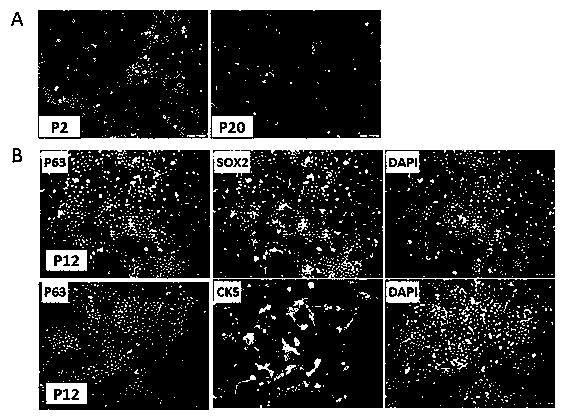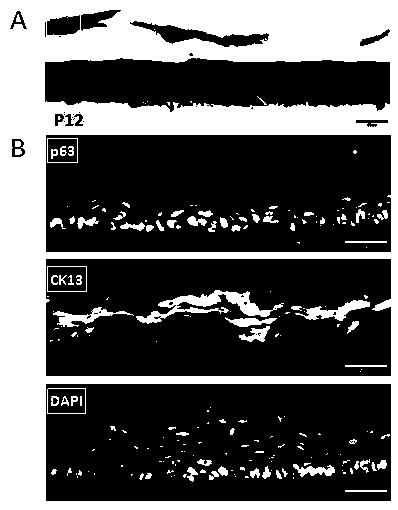Method for isolated culture of esophagus epithelial stem cells
A technology for separating and culturing stem cells, applied in the field of cell biology, which can solve the problems of unresearched methods of separating and culturing esophageal epithelial stem cells, and achieve the effects of prolonging cell activity, inhibiting multi-directional differentiation potential, and stabilizing heredity
- Summary
- Abstract
- Description
- Claims
- Application Information
AI Technical Summary
Problems solved by technology
Method used
Image
Examples
Embodiment 1
[0029] Isolation, culture and identification of human esophageal epithelial stem cells
[0030] 1.1 Isolation and culture
[0031] (1) Materials: Discarded normal epithelial tissue of the esophagus of a 69-year-old male was removed under aseptic conditions, and placed in phosphate-buffered saline (PBS) / normal saline solution containing penicillin 100ug / mL and streptomycin 100ug / mL In a sterile tube, take it back to the laboratory immediately;
[0032] (2) Separation: Wash the esophageal epithelial tissue 3 to 5 times with PBS containing 200 μg / mL penicillin / streptomycin, and remove hemorrhagic tissue, necrotic tissue and fibrovascular tissue; Scissors and ophthalmic forceps to trim the tissue to 0.5-1mm 3 Then add the centrifuge tube containing the digestion solution of 0.1% collagenase type I, 0.1% pronase and 0.5 mg / ml deoxyribonuclease I, and then put the centrifuge tube into a 37°C incubator for constant temperature digestion for 2h Afterwards, the digestion mixture was...
Embodiment 2
[0052] Isolation, culture and identification of mouse esophageal epithelial stem cells
[0053] 1. Cell isolation and culture
[0054] All animal studies were performed in full compliance with laboratory-grade animal standards. The normal esophageal tissues were taken out from the mice and washed three times with PBS containing antibiotics. Under sterile conditions, use sterile ophthalmic scissors and ophthalmic forceps to remove the hemorrhage and necrotic tissue in the esophagus, and cut them into pieces of 0.5-1mm 3 The small pieces were then added to the centrifuge tube containing the digestion solution of 0.1% pronase and 0.5 mg / ml DNase I. Digest at a constant temperature of 37°C for 3 hours, filter and centrifuge, and collect the cell pellet.
[0055] Resuspend the cells with the culture medium and place them in the culture bottle / dish covered with coating solution for horizontal culture, and culture the culture bottle / dish with EBSS containing 0.3mg / mL BSA and 40ug / ...
PUM
 Login to View More
Login to View More Abstract
Description
Claims
Application Information
 Login to View More
Login to View More - R&D
- Intellectual Property
- Life Sciences
- Materials
- Tech Scout
- Unparalleled Data Quality
- Higher Quality Content
- 60% Fewer Hallucinations
Browse by: Latest US Patents, China's latest patents, Technical Efficacy Thesaurus, Application Domain, Technology Topic, Popular Technical Reports.
© 2025 PatSnap. All rights reserved.Legal|Privacy policy|Modern Slavery Act Transparency Statement|Sitemap|About US| Contact US: help@patsnap.com



